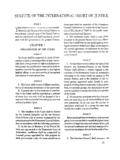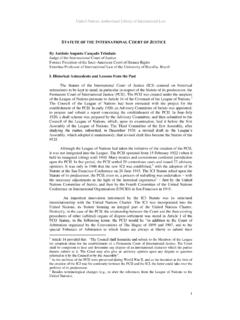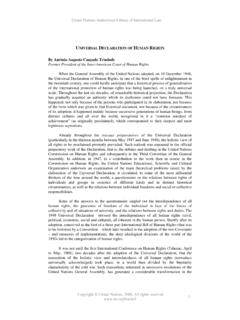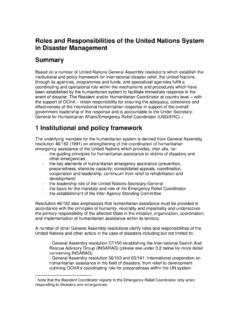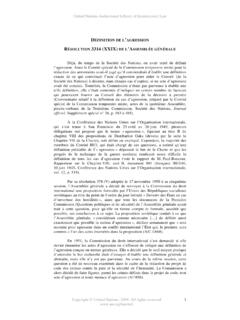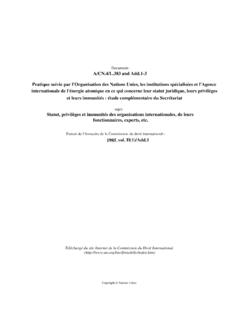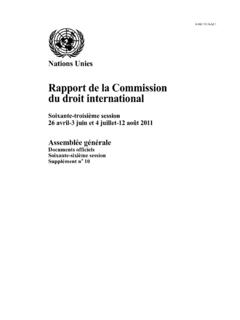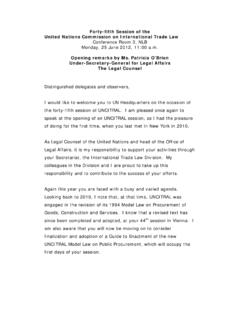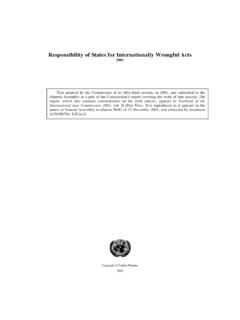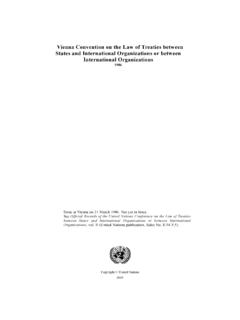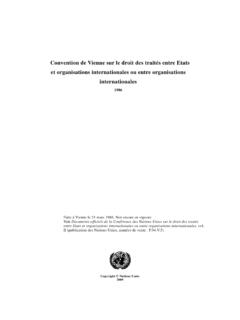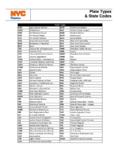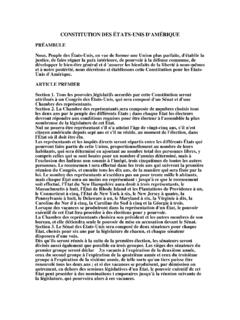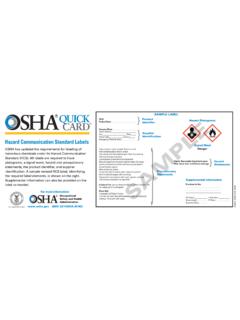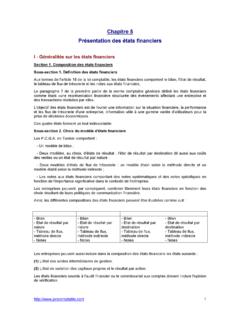Transcription of Handbook on the Peaceful Settlement of Disputes …
1 OLA/COD/2394 Office of Legal Affairs Codification DivisionHandbook on thePeaceful Settlement of Disputesbetween StatesUnited Nations New York, 1992 NOTES ymbols of United Nations documents are composed of capital letterscombined with figures. Mention of such a symbol indicates a reference to aUnited Nations NATIONS PUBLICATIONS ales No. 92-1-133428-4 Copyright United Nations 1992 All rights reservedManufactured in the United states of AmericaCONTENTSC hapter Paragraphs PageINTRODUCTION .. 11. PRINCIPLE OF THE Peaceful Settlement OF DISPUTESBETWEEN states .. 1-20 3A. Charter of the United Nations .. 1 3B. Declarations and resolutions of the GeneralA ssem bly .. 2 3C. Corollary and related principles .. 3-18 4D. Free choice of means .. 19-20 7II. MEANS OF Settlement .. 21-312 9A. Negotiations and consultations .. 21-73 91. M ain characteristics .. 22-26 92. Initial phase .. 27-36 103. Conduct of the negotiating process .. 37-67 13(a) Framework of the negotiating process 37-43 13(b) Place of negotiations.
2 44-46 14(c) Degree of publicity of the proceedings 47-49 15(d) Duration of the negotiation process .. 50-51 15(e) Attitude of the parties .. 52-58 16(f) Steps aimed at facilitating the negoti-ating process through the involvementof a third party .. 59-64 18(g) Question whether the existence of an on-going negotiation process precludes re-sort to another Peaceful settlementprocedure .. 65-67 204. Outcome of the negotiations and possiblesubsequent steps .. 68-73 21B. Inquiry .. 74-100 241. Functions and relation to other Peaceful meansunder the Charter of the United Nations .. 74-82 242. Initiation and methods of work .. 83-86 273. Composition and other institutional aspects 87-98 294. Outcome of the process .. 99-100 32 ChapterC .G ood offices ..1. Main characteristics, legal framework andrelation to other Peaceful means under theCharter of the United Nations ..2. Functions ..3. Application of the method ..4. Institutional and related aspects ..(a) Initiation of the procedure.
3 (b) Methods of work and venue ..5. Termination and outcome of the process ..D .M ediation ..1. Main characteristics and legal framework2. Functions ..3. Procedural and institutional aspects ..4. Outcome of the process ..E. Conciliation ..1. Main characteristics, legal framework andrelation to other Peaceful means under theCharter of the United Nations ..2. Functions ..3. Application of the method ..4. Institutional and related aspects ..(a) Composition ..(b) Initiation of the process ..(c) Rules of procedure and methods of work(d) Duration and termination ..(e) Expenses and other financial arrangements(f) Venue and secretariat of the commission5. Termination and outcome of the process ..F. A rbitration ..1. Main characteristics and legal framework2. Institutional and related aspects ..(a) Types of arbitration agreements.(b) Composition ..(c) Rules of procedure ..(d) Applicable law ..(e) Methods of work and proceedings beforethe tribunal ..Paragraphs Page101-122 33101-104105-110111-115116-120116-117118 -120121-122123-139123-126127-128129-1371 38-139140-167140-143144-146147-149150-16 3150-153154-155156-158159-160161162-1631 64-167168-195168-173174-191174-177178-17 9180181-182183-186 62 Chapter(f) Seat and administrative aspects of anarbitral tribunal.
4 (g) Expenses of an arbitral tribunal ..3. Outcome of arbitration and related issues ..G .Judicial settlem ent ..1. Main characteristics, legal framework andfunctions ..2. Resort to judicial Settlement ..3. Institutional and procedural aspects ..(a) Jurisdiction, competence and initiationof the process ..(b) Access and third-party intervention ..(c) Com position ..(d) Rules of procedure ..(e) Seat and administrative aspects ..(f) Expenses and other financial arrange-m ents ..4. Outcome of judicial Settlement ..H. Resort to regional agencies or arrangements ..1. Main characteristics, legal framework and re-lation to other means of Peaceful settlementprovided for by Article 33 of the Charter of theU nited N ations ..2. Institutional arrangements, competence andprocedure ..(a) League of Arab states ..(b) Organization of American states ..(c) Organization of African Unity ..(d) European Convention for the PeacefulSettlement of Disputes (Council ofE urope) ..(e) Conference on Security and Cooperationin Europe.
5 (f') European and inter-American systemsfor the protection of human rights ..(g) African Charter on Human and Peoples'R ights ..(h) European Communities ..(i) Economic Community of West AfricaParagraphs Page187-189190-191192-195196-229196-1992 00-201202-228202-212213-214215-217218-22 4225-227228229230-287230-237 81238-271239-241242-245246-250251-254 86255-258 87259-262 88263264-267268 Chapter(j) Agreements on shared managementof resources ..3. Actual resort to regional agencies or arrange-ments in dispute Settlement ..(a) League of Arab states ..(b) Organization of American states ..(c) Organization of African Unity ..(d) European Convention for the PeacefulSettlement of Disputes (Council ofE urope) ..4. Relations between regional agencies or ar-rangements and the United Nations in the fieldof the Peaceful Settlement of local disputes1. Other Peaceful means ..1. Main characteristics and legal framework2. Resort to other Peaceful means ..(a) Novel means which do not consist in theadaptation or combination of familiarm eans.
6 (b) Adaptations of familiar means ..(c) Combination of two or more familiarmeans in the work of a single organ ..III. PROCEDURES ENVISAGED IN THE CHARTER OF THEUNITED NATIONS ..A .Introduction ..B. The Security Council ..1. Role of the Security Council in the peacefulsettlement of Disputes ..(a) Investigation of Disputes and determi-nation as to whether a situation is infact likely to endanger internationalpeace and security ..(b) Recommendation to states parties to adispute to settle their Disputes bypeaceful means ..(c) Relation to procedures under regionalagencies or arrangements ..2. Recent trends ..C. The General Assembly ..1. Role of the General Assembly in the peacefulsettlement of Disputes ..Paragraphs Page269-271 91272-284273-276277-281282-283284 95285-287288-312288289-312290-295 99296-305 101306-312 106313-381313-315316-351316-335 111319-321 112322-332 114333-335336-351352-366352-362 123 Chapter(a) Discussion of questions and making rec-ommendations on matters relating to thepeaceful Settlement of Disputes .
7 (b) Recommendation of measures for thepeaceful adjustment of situations2. Recent trends ..D .The Secretariat ..1. Role of the Secretary-General ..(a) Functions of the Secretary-General in theimplementation of the resolutions ofother principal organs in the field of theprevention or Settlement of Disputes ..(b) Diplomatic functions ..(c) Functions of the Secretary-Generalbased on the powers expressly conferredupon him by the Charter ..2. Recent trends ..V. PROCEDURES ENVISAGED IN OTHER INTERNATIONALINSTRUM ENTS ..A .Introduction ..B. Procedures envisaged in the constituent instru-ments of international organizations of a universalcharacter other than the United Nations ..1. Procedures envisaged in economic and finan-cial organizations ..2. Procedures envisaged in the constitutions ofother international organizations with special-ized activities ..C. Procedures envisaged in multilateral treatiescreating no permanent institutions ..1. Conventions containing optional proceduresfor dispute Settlement .
8 2. Conventions containing non-compulsoryand compulsory procedures in which boththe International Court of Justice and anarbitral tribunal are established as choicesfor judicial Settlement ..3. Conventions in which resort to the Interna-tional Court of Justice is the only compulsoryjudicial Settlement procedure ..4. Conventions in which arbitration is the onlycompulsory procedure for judicial settlementParagraphs Page353-360 123361-362363-366367-381367-374368-370 128371 130372-374 130375-381 131382-430 135382-385 135386-417 136387-406 136407-417 142418-430 146419-421 147422 148423-424 149425 150 Chapter5. Conventions in which conciliation is the onlythird-party compulsory procedure ..6. Conventions combining adjudication andconciliation as compulsory procedures ..7. Conventions which rely on panels of expertsfor resolving technical Disputes ..Paragraphs Page426 151427-429 151430 152 ANNEXESI. Charter of the United Nations ..II. Statute of the International Court of Justice ..III.
9 Rules of the International Court of Justice of 14 April 1978 BIBLIOGRAPHY ..IN D EX ..INTRODUCTIONBy its resolutions 39/79 and 39/88 of 13 December 1984, the GeneralAssembly requested the Secretary-General to prepare, on the basis of theoutline elaborated by the Special Committee on the Charter of the UnitedNations and on the Strengthening of the Role of the Organization and in thelight of the views expressed in the course of the discussions in the SixthCommittee and in the Special Committee, a draft Handbook on the peacefulsettlement of Disputes between accordance with the conclusions reached by the Special Committee atits 1984 session with respect to the preparation of the draft Handbook , theSecretary-General was instructed to consult periodically a representativegroup of competent individuals from among the members of the PermanentMissions of the states Members of the United Nations in order to obtainassistance in the performance of his task.' At the 1985 session, it was agreedthat the "representative group of competent individuals from among themembers of the Permanent Missions of the states Members of the UnitedNations" would be open to all members of the Special Committee and thatthe group would have purely consultative functions.
10 'The Secretary-General accordingly consulted the above-mentioned rep-resentative group in preparing the various chapters of the Handbook . Thehandbook in its final form was approved by the Special Committee at its1991 purpose of the Handbook is to contribute to the Peaceful settlementof Disputes between states and to help to increase compliance with interna-tional law by providing states parties to a dispute, particularly those Stateswhich do not have the benefit of long-established and experienced legaldepartments, with the information they might need to select and apply proce-dures best suited to the Settlement of particular Handbook has been prepared in strict conformity with the Charter ofthe United Nations. It is descriptive in nature and is not a legal drawn up on consultation with Member states , it does not representthe views of Member conformity with the above-mentioned resolutions, the scope of thehandbook was to be limited to Disputes between states , excluding thosedisputes which although involving states fell under municipal law or werewithin the competence of domestic courts.
